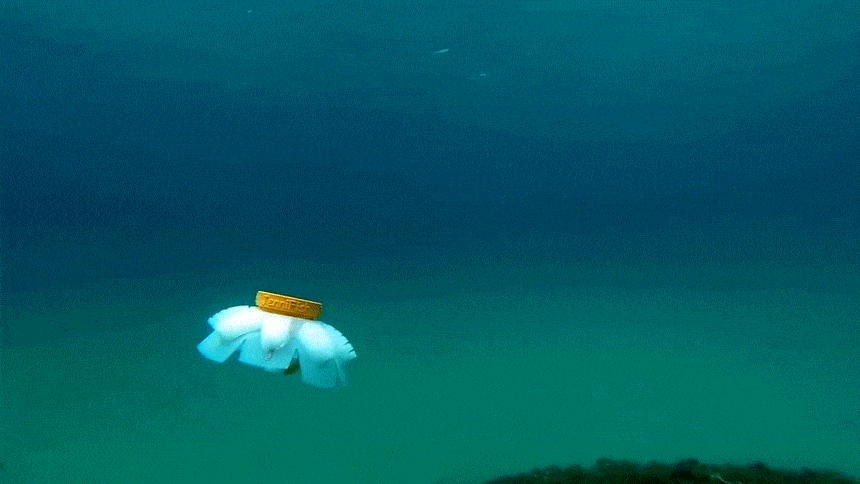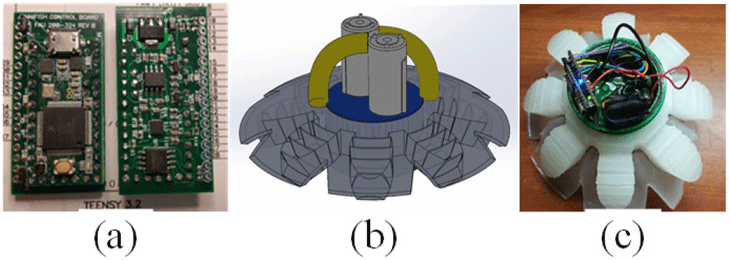This robotic jellyfish is a climate spy
Squishy tentacles let this gadget monitor coral reefs without disturbing them

A soft and squishy robo-jellyfish pumps its way gently through the ocean, providing little or no disturbance to local sea life.
Jennifer Frame, Nick Lopez, Oscar Curet and Erik D. Engeberg/IOP Publishing
To study coral reefs and the creatures that live there, scientists sometimes deploy underwater drones. But drones aren’t perfect spies. Their propellers can rip up reefs and harm living things. Drones also can be noisy, scaring animals away. A new robo-jellyfish might be the answer.
Erik Engeberg is a mechanical engineer at Florida Atlantic University in Boca Raton. His team developed the new gadget. Think of this robot as a quieter, gentler ocean spy. Soft and squishy, it glides silently through the water, so it won’t harm reefs or disturb animals living around them. The robot also carries sensors to collect data.
The device has eight tentacles made of soft silicone rubber. Pumps on the underside of the robot take in seawater and direct it into the tentacles. The water inflates the tentacles, making them stretch out. Then power to the pumps briefly cuts out. The tentacles now relax and water shoots back out of holes on the underside of the device. That rapidly escaping water propels the jellyfish upwards.

The robot also has a hard, cylindrical case on top. This holds the electronics that control the jellyfish and store data. One component allows wireless communication with the jellyfish. That means someone can remotely steer the robot by making different tentacles move at different times. The hard case could hold sensors, too.
Engeberg’s group described its robot’s design September 18 in Bioinspiration & Biomimetics.
Natural inspiration
The researchers had practical reasons for modeling their device on jellyfish. “Real jellyfish only need small amounts of power to travel from [point] A to B,” Engeberg says. “We wanted to really capture that quality in our jellyfish.”
Jellyfish move slowly and gently. So does the robo-jelly. That’s why the researchers think it won’t frighten marine animals. What’s more, Engeberg says, “The soft body of our jellyfish helps it to monitor ecosystems without damaging them.” For example, the robot could carry a sensor to record ocean temperatures. The data it gathered could help scientists map where and when the ocean is warming because of climate change.

“Jellyfish have been moving around our oceans for millions of years, so they are excellent swimmers,” says David Gruber. He’s a marine biologist at Baruch College in New York City who was not involved with the robot. “I’m always impressed when scientists get ideas from nature,” Gruber says. “Especially something as simple as the jellyfish.”
Fighting climate change motivates Engeberg and his team. “I have a deep desire to help endangered reefs around the world,” he says. He hopes his robo-jellyfish will help researchers study the otherwise hidden impacts of climate change at sea.
Tracking sea temperatures and other data can benefit people, too, by warning of worsening conditions. Warmer oceans can make storms more powerful and destructive. Warmer seawater also helps melt sea ice by eroding glaciers from below. That meltwater adds to rising sea levels. And higher seas can lead to coastal flooding, or make low-lying islands disappear altogether.
The robotic jellyfish is a work in progress. “We are making a new version right now,” Engeberg says. It swims deeper and can carry more sensors than the older model. This should make it an even better spy on the conditions affecting coral reefs worldwide.
This is one in a series presenting news on technology and innovation, made possible with generous support from the Lemelson Foundation.







